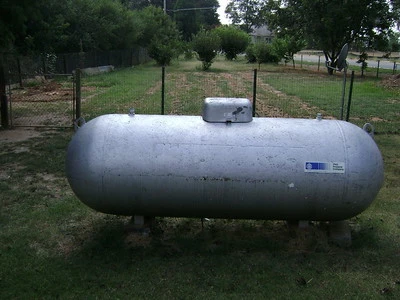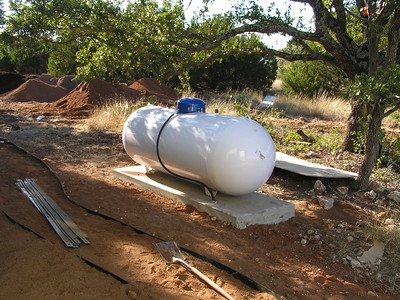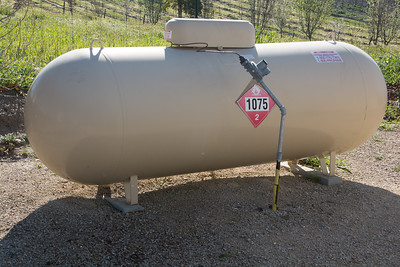
Your 500-gallon propane tank plays a crucial role in keeping your home or business running smoothly, whether it’s for heating, cooking, or powering appliances. Like any equipment, though, it doesn’t last forever. Over time, wear and tear can affect its safety and efficiency.
Knowing when to replace your propane tank can save you from potential problems down the road, like leaks or other dangerous situations.
In this article, we’ll walk you through the key signs that indicate it might be time to consider getting a new tank.
Situations and Instances That Prompt Replacement of a Propane Tank
- Age of the Tank:
- Propane tanks are designed to last a long time, typically between 30 to 40 years. However, as they get older, the materials can start to break down, even if you can’t see it from the outside. Internal components, like the valves and seals, can also wear out over time. If your tank is approaching or has exceeded this age range, it’s a good idea to replace it before problems start. An older tank may not be as safe or reliable as a newer one, and replacing it can help you avoid potential risks.
- Visible Damage:
- Over time, propane tanks can suffer from physical damage due to weather, accidental impacts, or general wear and tear. Rust, for example, is a sign that the tank’s metal is starting to corrode. If the rust is deep or widespread, it can weaken the tank’s structure, making it more prone to leaks. Dents, especially large ones, can compromise the tank’s ability to safely hold pressure. Cracks are even more serious because they can lead to immediate and dangerous propane leaks. If you notice any of these issues, it’s safer to replace the tank than to risk a potential failure.
- Pressure or Performance Problems:
- Propane tanks operate under pressure, typically between 100 to 200 PSI depending on the temperature. If your appliances aren’t performing as they should—like if the flame on your stove is weak or if your heater isn’t getting hot enough—it could be a sign that the tank isn’t maintaining proper pressure. This could be due to a problem with the tank’s regulator, valves, or even internal damage that isn’t visible from the outside. Low pressure or inconsistent performance can indicate that the tank is no longer functioning correctly and needs to be replaced to ensure your appliances work properly and safely.
- Frequent Repairs:
- While a propane tank might need occasional maintenance, frequent repairs are a sign that it’s reaching the end of its useful life. For example, if you’ve had to replace parts like the regulator or valves multiple times, or if you’ve needed to fix leaks or other issues more than once a year, it’s likely more cost-effective to replace the tank altogether. Continually repairing an aging or damaged tank can become expensive, and it might still fail in the near future. Replacing the tank can give you peace of mind and save money on ongoing repairs.
- Change in Propane Usage:
- If your household’s propane needs have increased, such as adding a propane-powered pool heater or a generator, your 500-gallon tank may no longer be sufficient. You might find yourself running out of propane more often and needing more frequent deliveries, which can be inconvenient and costly. Upgrading to a larger tank, like a 1,000-gallon model, can ensure you have enough propane to meet your needs without frequent refills. On the other hand, if you’ve reduced your propane usage—maybe you’ve switched some appliances to electric or you no longer use propane for heating—a smaller tank, such as a 250-gallon one, might be a better fit, saving you space and money.
- Failed Inspection:
- Regular inspections by a certified professional are crucial for ensuring your propane tank remains safe to use. During an inspection, the technician will check for issues like corrosion, weak spots in the tank’s metal, and the condition of the valves and fittings. If they find significant problems, like deep rust, internal corrosion, or failing valves, it’s a clear sign that the tank should be replaced. Even if the tank hasn’t yet reached the typical 30-40 year lifespan, a failed inspection means the tank is no longer safe and should be taken out of service immediately.
- Leaking Propane:
- Propane has a strong odor, often described as similar to rotten eggs, which is added to the gas to help detect leaks. If you smell propane around your tank or notice that the tank is losing gas even when you’re not using it, this indicates a leak. Leaks can occur due to damage, worn-out seals, or cracks in the tank. Even small leaks can be dangerous, as propane is highly flammable and can pose serious safety risks. If a leak persists after repairs, or if you’ve had multiple leaks, replacing the tank is the safest course of action to prevent accidents or potential explosions.
Understanding the Lifespan of a 500-Gallon Propane Tank
How long are 500-gallon propane tanks good for? It usually lasts around 30 to 40 years if it’s well-maintained. However, this lifespan can vary depending on a few factors. For example, the quality of the materials used to make the tank plays a big role—better materials often mean a longer-lasting tank. Another factor is where the tank is located.
If your tank is exposed to harsh weather, like extreme heat, cold, or moisture, it might wear out faster. On the other hand, if it’s protected from the elements, it could last longer. Regular maintenance and inspections also help extend the tank’s life.
Regular checks are important because they can catch small issues before they become big problems. For example, a little bit of rust might not seem like a big deal, but if left untreated, it can weaken the tank and shorten its lifespan.
Similarly, dents or other damage from accidents can impact how long your tank lasts. If your tank is well taken care of, it could last closer to 40 years, but if it faces a lot of wear and tear, it might need to be replaced sooner. Keeping an eye on your tank’s condition and addressing any issues early can help you get the most out of your 500-gallon propane tank.
Signs That Your Propane Tank May Need Replacement
- Rust, Dents, or Cracks:
Over time, your propane tank might start to show signs of rust, especially if it’s been exposed to moisture. Even a small amount of rust can begin to weaken the metal, making the tank less safe. If you see any dents, they might seem harmless, but they can affect the tank’s structure and potentially lead to leaks. Cracks are an even bigger red flag; if you spot any cracks, no matter how small, it’s a sign that the tank could fail and should be replaced right away. - Age of the Tank:
Propane tanks typically have a lifespan of 30 to 40 years. If your tank is reaching this age range, it’s time to seriously consider a replacement, even if it seems to be in good shape. Older tanks are more prone to developing issues like leaks, corrosion, or pressure problems. It’s better to replace an aging tank before these issues arise rather than risk a dangerous situation. - Pressure or Performance Problems:
If you’re having trouble getting consistent propane flow, or if the pressure seems lower than usual, these could be signs that your tank is no longer working properly. For example, if your appliances aren’t heating as efficiently or if you’re running out of propane faster than normal, these could indicate internal issues with the tank. The typical pressure inside a propane tank is around 100 to 200 PSI (pounds per square inch), depending on the temperature. If the pressure drops significantly, it might be a sign that the tank’s internal components are failing, and it’s time to replace the tank.
When to Consider Replacing Your Tank Even If It Seems Fine
- Upgrading to a More Efficient Model:
Even if your current 500-gallon propane tank is still working, upgrading to a newer model can make a noticeable difference in efficiency. Newer tanks often have improved designs that allow them to use propane more effectively, which can result in cost savings over time. For example, modern tanks may have better insulation, reducing propane loss due to temperature fluctuations. Over the course of a year, this could save you a significant amount of propane, especially if you use a lot for heating or appliances. Additionally, new tanks might come with safety upgrades, like better pressure relief valves or more accurate gauges, which can enhance both safety and convenience. Even though your old tank seems fine, these improvements could make an upgrade worthwhile. - Changes in Your Propane Usage:
If your propane needs have increased, such as adding a propane-powered generator, pool heater, or additional appliances, your 500-gallon tank might not be large enough to meet the demand. A larger tank, like a 1,000-gallon model, can provide more storage, reducing the frequency of refills and ensuring you don’t run out of propane when you need it most. On the flip side, if you’ve decreased your usage—maybe you’ve moved to a smaller home or switched some appliances to electric—a 500-gallon tank might be more than you need. In this case, downsizing to a smaller tank, like a 250-gallon one, could save you space and money. Matching your tank size to your current usage ensures that you’re not overpaying for propane or dealing with frequent deliveries.
Regular Maintenance and Inspections
- Importance of Regular Inspections for Safety and Extending Tank Life:
- Regular inspections are crucial for keeping your 500-gallon propane tank safe and in good working condition. These checks help identify small issues before they become big problems. For example, catching a bit of rust early can prevent it from spreading and weakening the tank. Regular maintenance can also extend the life of your tank, helping it last closer to the 30 to 40 years that it’s designed for. Inspections aren’t just about safety—they can save you money in the long run by preventing costly repairs or the need for a premature replacement.
- What Professionals Look for During an Inspection:
- Valve Condition: The valves on your tank control the flow of propane. A professional will check to make sure they are in good condition and functioning properly. If a valve is worn out or damaged, it can lead to leaks or problems with propane flow, which can be dangerous.
- Tank Integrity: The technician will also examine the tank itself, looking for any signs of damage like rust, dents, or cracks. They’ll check both the outside and, if possible, the inside of the tank. If the tank’s integrity is compromised, it might not be able to hold pressure properly, which is a safety risk.
- Pressure Testing: Professionals may also test the tank’s pressure to make sure it’s within the normal range (100 to 200 PSI). If the pressure is too low or too high, it could indicate a problem with the tank that needs to be addressed.
- Fittings and Connections: All the connections between the tank and your propane system are inspected for leaks or wear. Ensuring that these are tight and in good shape is vital for preventing gas leaks.
By having regular inspections, you can catch potential issues early and ensure your propane tank stays safe and reliable for as long as possible.
To Conclude This
Knowing when to replace your 500-gallon propane tank is important for both safety and efficiency. Whether it’s due to age, visible damage, performance issues, or simply changing needs, replacing the tank at the right time can help you avoid problems and keep your home running smoothly.
Regular inspections and staying aware of the tank’s condition will ensure that you make the right decision before any serious issues arise. If you’re unsure, it’s always a good idea to consult a professional to help determine the best course of action.
Image source: MrKrako (Flickr)

Mike is an experienced propane technician with over 15 years of professional experience in the field. He has dedicated his career to helping customers with their propane needs, from installation to maintenance and repair. Together with Jeremy, he co-founded this website to provide useful information and guidance to customers seeking reliable propane services.



